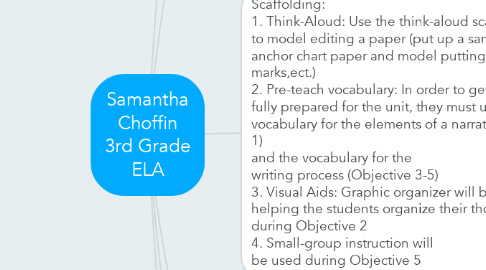Samantha Choffin 3rd Grade ELA
by Samantha Choffin

1. Standards covered in Unit Plan: 3.W.4 Produce clear and coherent writing in which the development, organization, and style are appropriate to task, purpose, and audience.
2. Objectives for 3.W.4 1. Students will be able to identify and take notes on the following specific stylistic elements; setting, dialogue, description, sequence of events, and characters, and basic organizational structure found in narrative writing by the end of the ELA period. 2. Students will be able to create a narrative based on a photo provided by the teacher by the end of the ELA period; the student will be able to ensure that the stylistic elements of narratives are present in the composition.
3. Standard covered in Unit Plan: 3.W.5 Develop and strengthen writing as needed by planning, revising, editing, and rewriting
4. Objectives for 3.W.5 3.Students will be able to read a narrative sample during a peer review and identify the stylistic elements and organizational structure and evaluate it effectiveness through highlighting and annotating the text, by the end of ELA period. 4. Students will be able to evaluate comments made during peer review and make a specific plan for revisions. Students will be able to write a specific plan that outlines what comments were made during peer review, what changes they plan to make in their narrative and how they think the changes will effect their writing, which should be completed within 2 ELA periods. 5. Students will be able to use their plans to revise and edit their narrative pieces. Students will make specific changes to emphasize the narrative stylistic elements and the organization of their piece, while also noting conventions and fluency, which should be completed in one ELA period.
5. Big Ideas: The aim of these lessons is to get students practiced in writing narratives and to get students to pay close attention to the specific elements that make a narrative successful. Students will gain experience in defining and identifying narrative elements and will gain experience in composing narratives.
6. Scaffolding: 1. Think-Aloud: Use the think-aloud scaffolding strategy to model editing a paper (put up a sample paper on anchor chart paper and model putting it editing marks,ect.) 2. Pre-teach vocabulary: In order to get the students fully prepared for the unit, they must understand the vocabulary for the elements of a narrative (Objective 1) and the vocabulary for the writing process (Objective 3-5) 3. Visual Aids: Graphic organizer will be used for helping the students organize their thoughts during Objective 2 4. Small-group instruction will be used during Objective 5
6.1. The think-aloud model was chosen because of my ELL student's needs. Instead of having them take notes on what it means to read a peer's work and edit it, I would find a sample narrative piece and walk through reading it, and making changes on the paper so all of the students could hear and visualize the process I went through of reading my peer's work and editing it.
6.2. Pre-Teaching Vocabulary is another scaffolding strategy chosen because of my students being ELL (All 24 of them in my class are). It is impossible for them to really effectively work through a lesson when they are not understanding the vocabulary. Spending time learning the vocabulary (parts of a narrative) would be the first thing to do, prior to starting this unit. The first day I would print out a narrative and spend time highlighting the different parts in different colors, with students (example, highlight the dialogue in pink, the characters in blue, ect.). When it comes time for the first lesson of the unit, students are already familiar with the parts of a narrative
6.3. Visual aids are another scaffolding strategy necessary for the student's success in this unit. Sometimes their thoughts get jumbled up, or they don't really know even where to begin when starting a writing assignment. Graphic organizers help guide them in including the elements needed.
6.4. Small-group instruction will be used when students are making the necessary changes to their narratives. Some of my students have trouble being able to put into practice what their peer's have said, so I will be pulling a few select students to help them in implementing the changes their peer's suggested for their final drafts.


